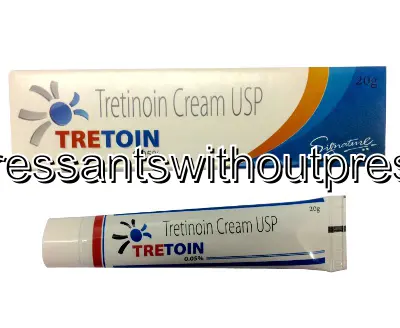| Package | Dosage | Price | Price per Dose | |
|---|---|---|---|---|
| Dosage: 0.025% | ||||
| 15 tube | 0.025% | £257.46 | £17.16 | |
| 10 tube | 0.025% | £193.69 | £19.37 | |
| 3 tube | 0.025% | £63.77 | £21.26 | |
| Dosage: 0.05% | ||||
| 15 tube | 0.05% | £277.54 | £18.51 | |
| 10 tube | 0.05% | £207.86 | £20.79 | |
| 3 tube | 0.05% | £68.49 | £22.83 | |

Tretinoin Description
Overview of Tretinoin
Tretinoin is a well-known medication commonly used in dermatology for treating various skin conditions. It is a derivative of vitamin A, also called all-trans retinoic acid. Its primary purpose is to promote skin cell turnover, helping to improve the overall appearance of the skin. Due to its powerful effects, tretinoin is often prescribed for acne treatment, reducing the severity and preventing future breakouts. It is available in different formulations, including creams, gels, and liquids, allowing for flexible application depending on the patient's needs.
Effectiveness and Benefits
Many users find tretinoin highly effective in managing acne, especially when other treatments have failed. It can clear existing blemishes, diminish blackheads, and reduce inflammation associated with acne. Over time, tretinoin also helps improve skin texture and tone, making the skin look smoother and more youthful. Even beyond acne, tretinoin is sometimes used to treat signs of skin aging, such as fine lines and dark spots, thanks to its cell-renewing properties. Regular use leads to a brighter, more even complexion and a reduction in clogged pores.
Usage and Application
When using tretinoin, it is important to follow the instructions provided by a healthcare professional. Typically, a small amount is applied once daily, usually at night, to clean, dry skin. Users are advised to start with a lower concentration to minimize irritation and gradually increase use if tolerated. It is essential to apply sunscreen during the day, as tretinoin can increase skin sensitivity to ultraviolet light. Consistent application over several weeks or months is required to see significant improvements. Patience is key, as results may take time to become visible.
Possible Side Effects
While tretinoin can be highly effective, it may also cause some side effects. In the initial stages of treatment, users might experience redness, peeling, dryness, or mild irritation. These symptoms often diminish with continued use as the skin adjusts. To reduce discomfort, applying a moisturizer and using gentle skin care products can help. Rarely, some individuals might develop more severe reactions, such as blistering or increased skin sensitivity. It is important to consult a healthcare professional if adverse reactions occur or persist.
Precautions and Recommendations
Before starting tretinoin, it is advisable to discuss your skin condition with a healthcare provider. People with sensitive skin or certain skin conditions should use tretinoin cautiously. Pregnant or breastfeeding women are generally advised to avoid tretinoin unless prescribed by a doctor, due to potential risks. Sun exposure should be minimized during treatment, and protective clothing and sunscreen are recommended. It is also important to avoid using harsh or abrasive skin products alongside tretinoin to prevent excessive irritation.
Conclusion
Tretinoin remains a cornerstone in dermatological treatments for acne and skin renewal. Its ability to promote skin cell turnover makes it a potent tool for improving skin texture and clarity. However, users must be aware of its potential side effects and take necessary precautions. Proper application, patience, and guidance from a healthcare professional can help maximize the benefits of tretinoin while minimizing any adverse effects. Overall, it is considered a valuable medication for those seeking to enhance their skin's appearance and health.
See Also

